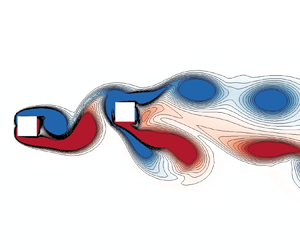Published online by Cambridge University Press: 30 April 2024

The flow-induced vibrations (FIVs) of two identical tandem square cylinders with mass ratio m* = 3.5 at Reynolds number Re = 150 are investigated through two-dimensional direct numerical simulation (DNS) and linear stability analysis over a parameter range of spacing ratio 1.5 ≤ L* ≤ 5 and reduced velocity 3 ≤ Ur ≤ 34. Three kinds of FIV responses, namely vortex-induced vibration (VIV), biased oscillation (BO) and galloping (GA), are identified. The FIVs are then further classified into the branches of initial VIV (IV), resonant VIV (RV and RV′), flutter-induced VIV (FV), desynchronized VIV (DV), VIV developing from GA (GV), transitional state between VIV and GA (TR), BO and GA based on the characteristics of the vibration responses. The transitions among different FIV branches are examined by combining the DNS with linear stability analysis, where the transition boundaries among the VIV, BO and GA branches over the concerned parameters are identified on the branch maps. The transition from IV to RV or RV′ is found to be related to the unstable wake mode, while the FV, transiting from RV or RV′, is induced by the unstable structural factor in the wake-structure mode. The structural instability is considered as the physical origin of GA, whereas the mode competition between unstable wake and structure leads to DV, GV and TR, and thus delays the appearance of GA. The transition from DV to BO with biased equilibrium position, accompanied by the even-order harmonic frequencies, is essentially induced by the symmetry breaking bifurcation.
To send this article to your Kindle, first ensure no-reply@cambridge.org is added to your Approved Personal Document E-mail List under your Personal Document Settings on the Manage Your Content and Devices page of your Amazon account. Then enter the ‘name’ part of your Kindle email address below. Find out more about sending to your Kindle. Find out more about saving to your Kindle.
Note you can select to save to either the @free.kindle.com or @kindle.com variations. ‘@free.kindle.com’ emails are free but can only be saved to your device when it is connected to wi-fi. ‘@kindle.com’ emails can be delivered even when you are not connected to wi-fi, but note that service fees apply.
Find out more about the Kindle Personal Document Service.
To save this article to your Dropbox account, please select one or more formats and confirm that you agree to abide by our usage policies. If this is the first time you used this feature, you will be asked to authorise Cambridge Core to connect with your Dropbox account. Find out more about saving content to Dropbox.
To save this article to your Google Drive account, please select one or more formats and confirm that you agree to abide by our usage policies. If this is the first time you used this feature, you will be asked to authorise Cambridge Core to connect with your Google Drive account. Find out more about saving content to Google Drive.